The Influence of the Addition of Basalt Powder on the Properties of Foamed Geopolymers
Abstract
1. Introduction
2. Materials and Methods
3. Results
4. Market Analysis and the Appropriateness of Using Basalt as an Addition to Geopolymers
5. Conclusions
- As the amount of basalt powder added increases, the porosity structure changes. More spheroidal pores are formed and more pores of smaller sizes are created. This relationship was observed as a result of microscopic observations. This is probably related to the change in the consistency of the geopolymer mixture and its surface tension, which results in the formation of pores of different sizes more than in the case of a geopolymer mixture without the addition of basalt.
- The addition of basalt powder has a positive effect on the stability of foamed structures and the ability to foam the geopolymer mass. The addition of 5% basalt powder causes an increase in density by 14%, as well as an increase in compressive strength by 63% and an increase in bending strength by 20%. The insulating properties due to the addition of 5% basalt powder decreased only by less than 7%. These dependencies result from the change in the consistency of the geopolymer mixture with the addition of basalt. The addition of 5% basalt is the optimal proportion of this addition because the highest increase in compressive strength was achieved with a slight deterioration of insulating properties (by 7%) despite an increase in density by 14%.
- Further research should be carried out to optimize the share of basalt powder and optimize the molar ratios of activating solutions, taking into account that some of the basalt is reactive and takes part in the geopolymerization reaction and does not only act as a filler. The addition of basalt powder to geopolymers can contribute to the improvement of several parameters, such as: improvement of strength properties and abrasion resistance; improvement of thermal and insulating properties; increase in the ability to accumulate energy; porosity reduction; increased corrosion resistance in aggressive environments; reducing shrinkage and the risk of cracking. The ecological aspect is also important here because it is possible to use basalt in crushed form as waste. The effectiveness of the addition of powdered basalt will depend on many factors, including the origin of this material and its chemical and phase composition. Undoubtedly, further work should be carried out and the proportions of basalt addition should be adjusted to specific application requirements. It is also inevitable to take into account and accept a certain compromise because it is known that the addition of basalt will not improve all properties.
Author Contributions
Funding
Institutional Review Board Statement
Informed Consent Statement
Data Availability Statement
Conflicts of Interest
References
- Davidovits, J. Geopolymer Chemistry and Applications, 4th ed.; Geopolymere Institut: Saint-Quentin, France, 2008. [Google Scholar]
- Davidovits, J. 30 Years of Successes and Failures in Geopolymer Applications. Market Trends and Potential Breakthroughs. In Proceedings of the Geopolymer 2002 Conference, Melbourne, Australia, 28–29 October 2002. [Google Scholar]
- Provis, J.L.; van Deventer, J.S.J. Geopolymers: Structure, Processing, Properties, and Industrial Applications; A volume in Woodhead Publishing Series in Civil and Structural Engineering; Woodhead Publishing: Cambridge, UK, 2009. [Google Scholar]
- Provis, J.L. Geopolymers and other alkali activated materials: Why, how, and what? Mater. Struct. 2014, 47, 11–25. [Google Scholar] [CrossRef]
- Occhicone, A.; Graziuso, S.G.; De Gregorio, E.; Montagnaro, F.; Ricciotti, L.; Tarallo, O.; Roviello, G.; Ferone, C. Synthesis and characterization of new acid-activated red mud-metakaolin geopolymers and comparison with their alkaline counterparts. J. Clean. Prod. 2024, 435, 140492. [Google Scholar] [CrossRef]
- Tang, W.; Pignatta, G.; Sepasgozar, S.M.E. Life-Cycle Assessment of Fly Ash and Cenosphere-Based Geopolymer Material. Sustainability 2021, 13, 11167. [Google Scholar] [CrossRef]
- Kočí, V.; Černý, R. Directly foamed geopolymers: A review of recent studies. Cem. Concr. Compos. 2022, 130, 104530. [Google Scholar] [CrossRef]
- Zhang, Z.; Provis, J.L.; Reid, A.; Wang, H. Mechanical, thermal insulation, thermal resistance and acoustic absorption properties of geopolymer foam concrete. Cem. Concr. Compos. 2015, 62, 97–105. [Google Scholar] [CrossRef]
- Skvara, F.; Sulc, R.; Tisler, Z.; Skricik, P.; Smilauer, V.; Zlamalova Cilova, Z. Preparation and properties of fly as-based geopolymer foams. Ceram. Silik. 2014, 58, 188–197. [Google Scholar]
- Łach, M.; Mierzwiński, D.; Korniejenko, K.; Mikuła, J. Geopolymer foam as a passive fire protection. MATEC Web Conf. Fire Environ. Saf. Eng. 2018, 247, 00031. [Google Scholar] [CrossRef][Green Version]
- Łach, M.; Pławecka, K.; Bąk, A.; Lichocka, K.; Korniejenko, K.; Cheng, A.; Lin, W.T. Determination of the influence of hydraulic additives on the foaming process and stability of the produced geopolymer foams. Materials 2021, 14, 5090. [Google Scholar] [CrossRef]
- Abbas, R.; Khereby, M.A.; Ghorab, H.Y.; Elkhoshkhany, N. Preparation of geopolymer concrete using Egyptian kaolin clay and the study of its environmental effects and economic cost. Clean. Technol. Environ. Policy 2020, 22, 669–687. [Google Scholar] [CrossRef]
- Wang, Q.; Su, H.L.; Li, C.M.; Lyu, X.J. Recycling of steel slag as an alkali activator for blast furnace slag: Geopolymer preparation and its application in composite cement. Clean. Technol. Environ. Policy 2023, 25, 1617–1629. [Google Scholar] [CrossRef]
- Zarębska, K.; Zabierowski, P.; Gazda-Grzywacz, M.; Czuma, N.; Baran, P. Fly ash-based geopolymers with refractoriness properties. Clean. Technol. Environ. Policy 2022, 24, 2161–2175. [Google Scholar] [CrossRef]
- Basalt: Igneous Rock—Pictures, Definition, Uses & More. Available online: https://geology.com/rocks/basalt.shtml (accessed on 15 March 2024).
- Dobiszewska, M.; Beycioğlu, A. Physical Properties and Microstructure of Concrete with Waste Basalt Powder Addition. Materials 2020, 13, 3503. [Google Scholar] [CrossRef]
- Dobiszewska, M.; Barnes, R.W. Properties of Mortar Made with Basalt Powder as Sand Replacement. ACI Mater. J. 2020, 117, 3–9. [Google Scholar] [CrossRef]
- Kostrzewa-Demczuk, P.; Stepien, A.; Dachowski, R.; Krugiełka, A. The use of basalt powder in autoclaved brick as a method of production waste management. J. Clean. Prod. 2021, 320, 128900. [Google Scholar] [CrossRef]
- Ponzi, G.G.D.; Mendes dos Santos, V.H.J.; Martel, R.B.; Pontin, D.; e Stepanha, A.S.D.G.; Schütz, M.K.; Menezes, S.C.; Einloft, S.M.O.; Vecchia, F.D. Basalt powder as a supplementary cementitious material in cement paste for CCS wells: Chemical and mechanical resistance of cement formulations for CO2 geological storage sites. Int. J. Greenh. Gas. Control 2021, 109, 103337. [Google Scholar] [CrossRef]
- Pavlis, R. Rock Dust: Can It Remineralize the Earth? Available online: https://www.gardenmyths.com/rock-dust-remineralize-earth/ (accessed on 15 March 2024).
- Goll, D.S.; Ciais, P.; Amann, T.; Buermann, W.; Chang, J.; Eker, S.; Hartmann, J.; Janssens, I.; Li, W.; Obersteiner, M.; et al. Potential CO2 removal from enhanced weathering by ecosystem responses to powdered rock. Nat. Geosci. 2021, 14, 545–549. [Google Scholar] [CrossRef]
- Yang, H.; Liu, L.; Yang, W.; Liu, H.; Ahmad, W.; Ahmad, A.; Aslam, F.; Joyklad, P. A comprehensive overview of geopolymer composites: A bibliometric analysis and literature review. Case Stud. Constr. Mater. 2022, 16, e00830. [Google Scholar] [CrossRef]
- Krishna, R.S.; Mishra, J.; Zribi, M.; Adeniyi, F.; Saha, S.; Baklouti, S.; Shaikh, F.U.A.; Gökçe, H.S. A review on developments of environmentally friendly geopolymer technology. Materialia 2021, 20, 101212. [Google Scholar] [CrossRef]
- Furtos, G.; Prodan, D.; Sarosi, C.; Moldovan, M.; Korniejenko, K.; Miller, L.; Fiala, L.; Iveta, N. Mechanical Properties of MiniBars™ Basalt Fiber-Reinforced Geopolymer Composites. Materials 2024, 17, 248. [Google Scholar] [CrossRef]
- Annadurai, S.; Baskar, P.; Elango, K.S. Geopolymer concrete reinforced with basalt fibers: An experimental investigation. Mater. Today Proc. 2023; in press. [Google Scholar] [CrossRef]
- Punurai, W.; Kroehong, W.; SaptamongkoL, A.; Chindaprasirt, P. Mechanical properties, microstructure, and drying shrinkage of hybrid fly ash-basalt fiber geopolymer paste. Constr. Build. Mater. 2015, 186, 62–70. [Google Scholar] [CrossRef]
- Li, M.; Gong, F.; Wu, Z. Study on mechanical properties of alkali-resistant basalt fiber reinforced concrete. Constr. Build. Mater. 2020, 245, 118424. [Google Scholar] [CrossRef]
- Le, V.S.; Hájková, P.; Kovacic, V.; Bakalova, T.; Lukáš, V.; Le, C.H.; Seifert, K.C.; Peres, A.P.; Louda, P. Thermal conductivity of reinforced geopolymer foams. J. Ceram.-Silik. 2019, 63, 365–373. [Google Scholar] [CrossRef]
- Le, V.S.; Szczypinski, M.M.; Hájková, P.; Kovacic, V.; Bakalova, T.; Volesky, L.; Hiep, L.C.; Louda, P. Mechanical properties of geopolymer foam at high temperature. Sci. Eng. Compos. Mater. 2020, 27, 129–138. [Google Scholar] [CrossRef]
- Le, V.S.; Louda, P. Research of Curing Time and Temperature-Dependent Strengths and Fire Resistance of Geopolymer Foam Coated on an Aluminum Plate. Coatings 2021, 11, 87. [Google Scholar] [CrossRef]
- Le, V.S.; Nguyen, V.V.; Sharko, A.; Ercoli, R.; Nguyen, T.X.; Tran, D.H.; Łoś, P.; Buczkowska, K.E.; Mitura, S.; Špirek, T.; et al. Fire Resistance of Geopolymer Foams Layered on Polystyrene Boards. Polymers 2022, 14, 1945. [Google Scholar] [CrossRef]
- Wang, J.; Li, X.; Hu, Y.; Li, Y.; Hu, P.; Zhao, Y. Physical and high temperature properties of basalt fiber-reinforced geopolymer foam with hollow microspheres. Constr. Build. Mater. 2024, 411, 134698. [Google Scholar] [CrossRef]
- Gencel, O.; Nodehi, M.; Bayraktar, O.Y.; Kaplan, G. Basalt fiber-reinforced foam concrete containing silica fume: An experimental study. Constr. Build. Mater. 2022, 326, 126861. [Google Scholar] [CrossRef]
- Venyite, P.; Makone, E.C.; Kaze, R.C.; Nana, A.; Nemaleu, J.G.D.; Kamseu, E.; Melo, U.E.; Leonelli, C. Effect of Combined Metakaolin and Basalt Powder Additions to Laterite-Based Geopolymers Activated by Rice Husk Ash (RHA)/NaOH Solution. Silicon 2022, 14, 1643–1662. [Google Scholar] [CrossRef]
- Ismaiel Saraya, M.; El-Fadaly, E. Preliminary Study of Alkali Activation of Basalt: Effect of NaOH Concentration on Geopolymerization of Basalt. J. Mater. Sci. Chem. Eng. 2017, 5, 58–76. [Google Scholar] [CrossRef]
- Kozub, B.; Miernik, K.; Gądek, S. A Study of Fly Ash-Based Geopolymers with Basalt Flour Addition. Mater. Proc. 2023, 13, 3. [Google Scholar] [CrossRef]
- Dobiszewska, M.; Pichór, W.; Szołdra, P. Effect of basalt powder addition on properties of mortar. MATEC Web Conf. 2019, 262, 06002. [Google Scholar] [CrossRef]
- Ziada, M.; Erdem, S.; Tammam, Y.; Kara, S.; Lezcano, R.A.G. The Effect of Basalt Fiber on Mechanical, Microstructural, and High-Temperature Properties of Fly Ash-Based and Basalt Powder Waste-Filled Sustainable Geopolymer Mortar. Sustainability 2021, 13, 12610. [Google Scholar] [CrossRef]
- Aktürk, B.; Kızılkanat, A.B.; Kabay, N.; Akyüncü, V. Utilization of Basalt Powder as Geopolymeric Binder. International Conference on “Cement—Based Materials Tailored for a Sustainable Future” 27–29 May 2021—Istanbul/TURKEY. Available online: https://www.researchgate.net/profile/Busra-Akturk-3/publication/357484979_Utilization_of_Basalt_Powder_as_Geopolymeric_Binder/links/61d08405da5d105e5511e3e4/Utilization-of-Basalt-Powder-as-Geopolymeric-Binder.pdf (accessed on 15 March 2024).
- Unčík, S.; Kmecová, V. The Effect of Basalt Powder on the Properties of Cement Composites. Procedia Eng. 2013, 65, 51–56. [Google Scholar] [CrossRef]
- PN-EN 12390-3:2019; Testing Hardened Concrete—Part 3: Compressive Strength of Test Specimens. PKN: Warsaw, Poland, 2019.
- PN-EN 12390-5:2019; Testing Hardened Concrete—Part 5: Flexural Strength of Test Specimens. PKN: Warsaw, Poland, 2019.
- JC/T2200-2013; Foamed Cement Insulation Panel. Standards Press of China: Beijing, China, 2013.
- Available online: https://www.statista.com/statistics/248194/average-price-of-kaolin/ (accessed on 21 April 2024).
- Available online: https://www.made-in-china.com/products-search/hot-china-products/Metakaolin_Price.html (accessed on 21 April 2024).
- Geopolymer Market: Global Industry Analysis and Forecast (2023–2029). Available online: https://www.maximizemarketresearch.com/market-report/global-geopolymer-market/81356/ (accessed on 15 March 2024).


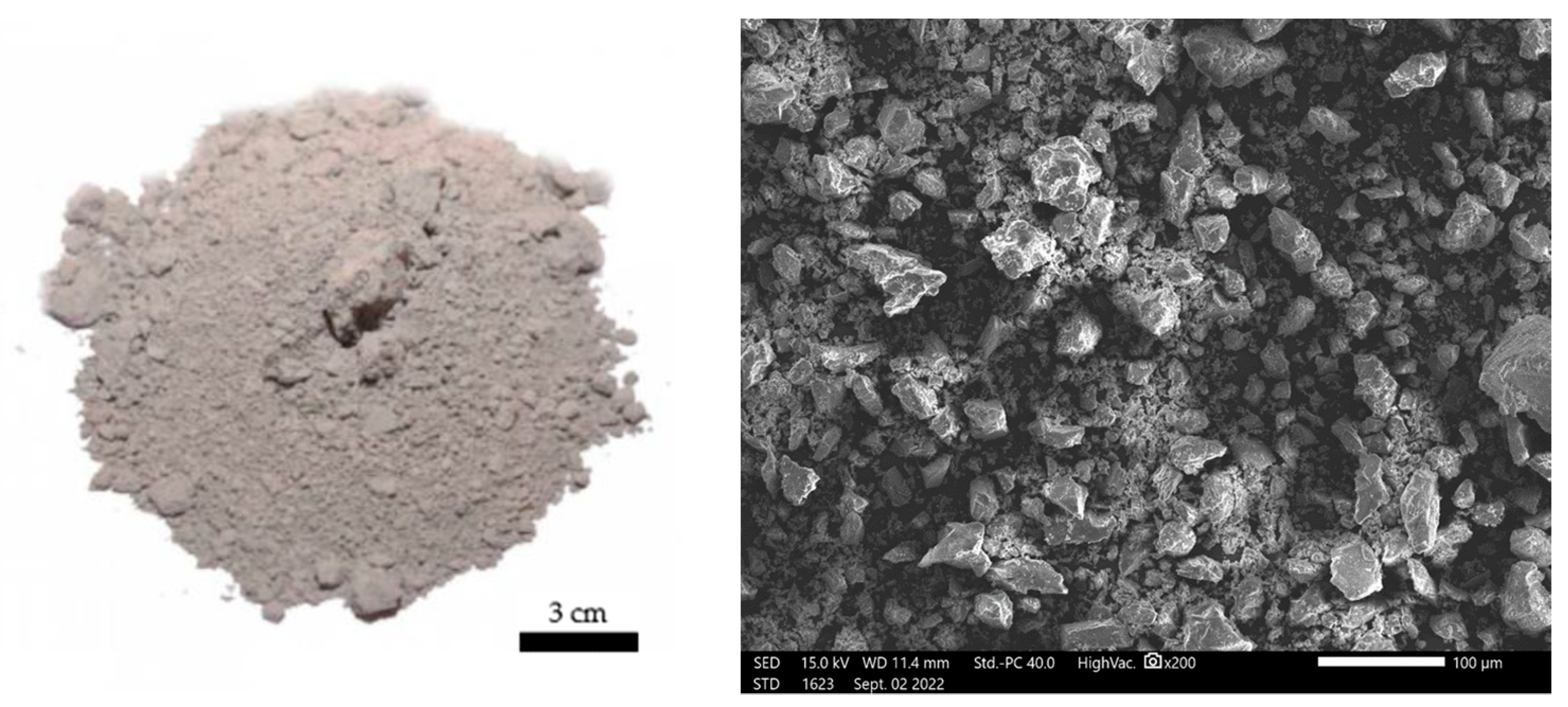

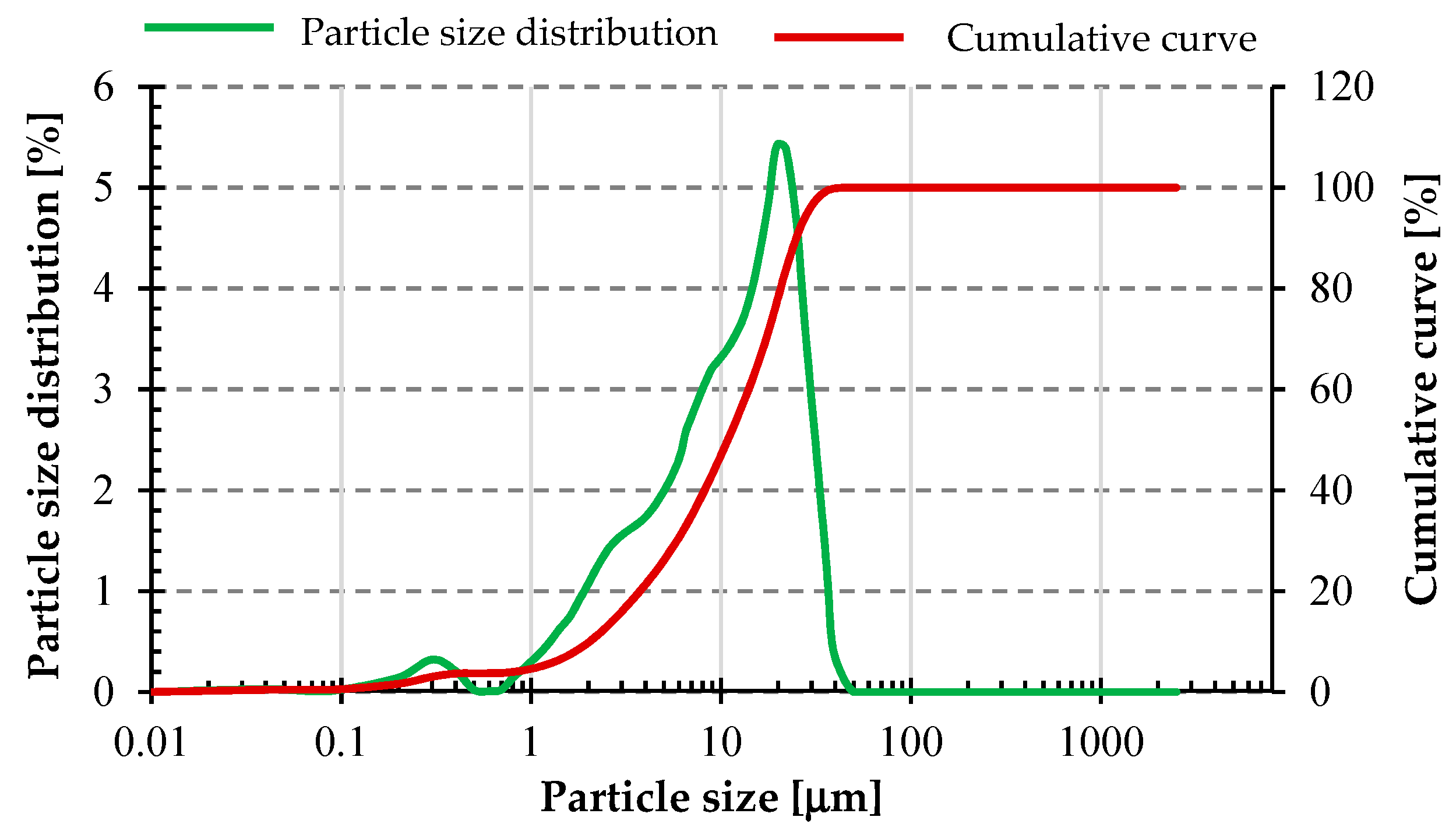

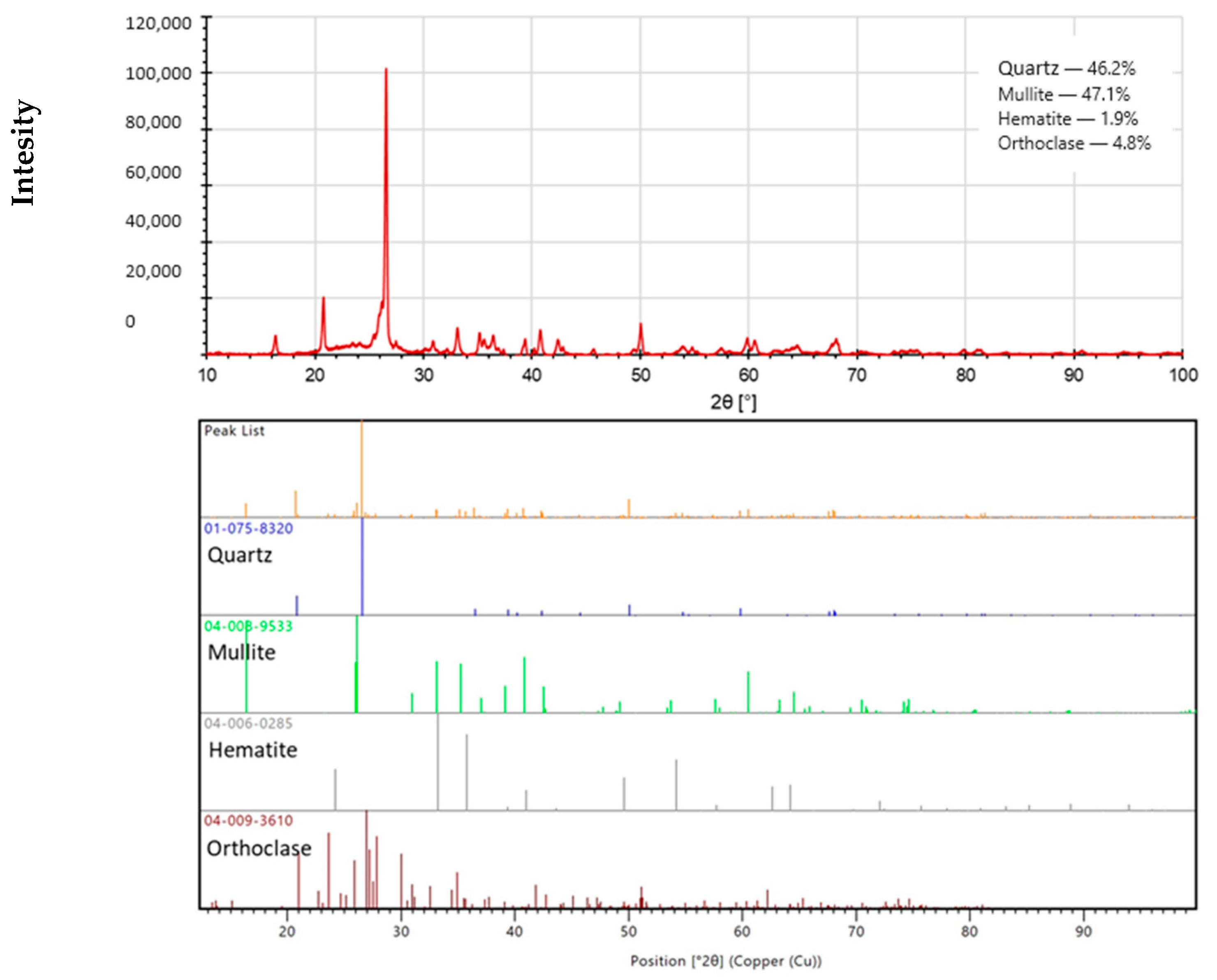
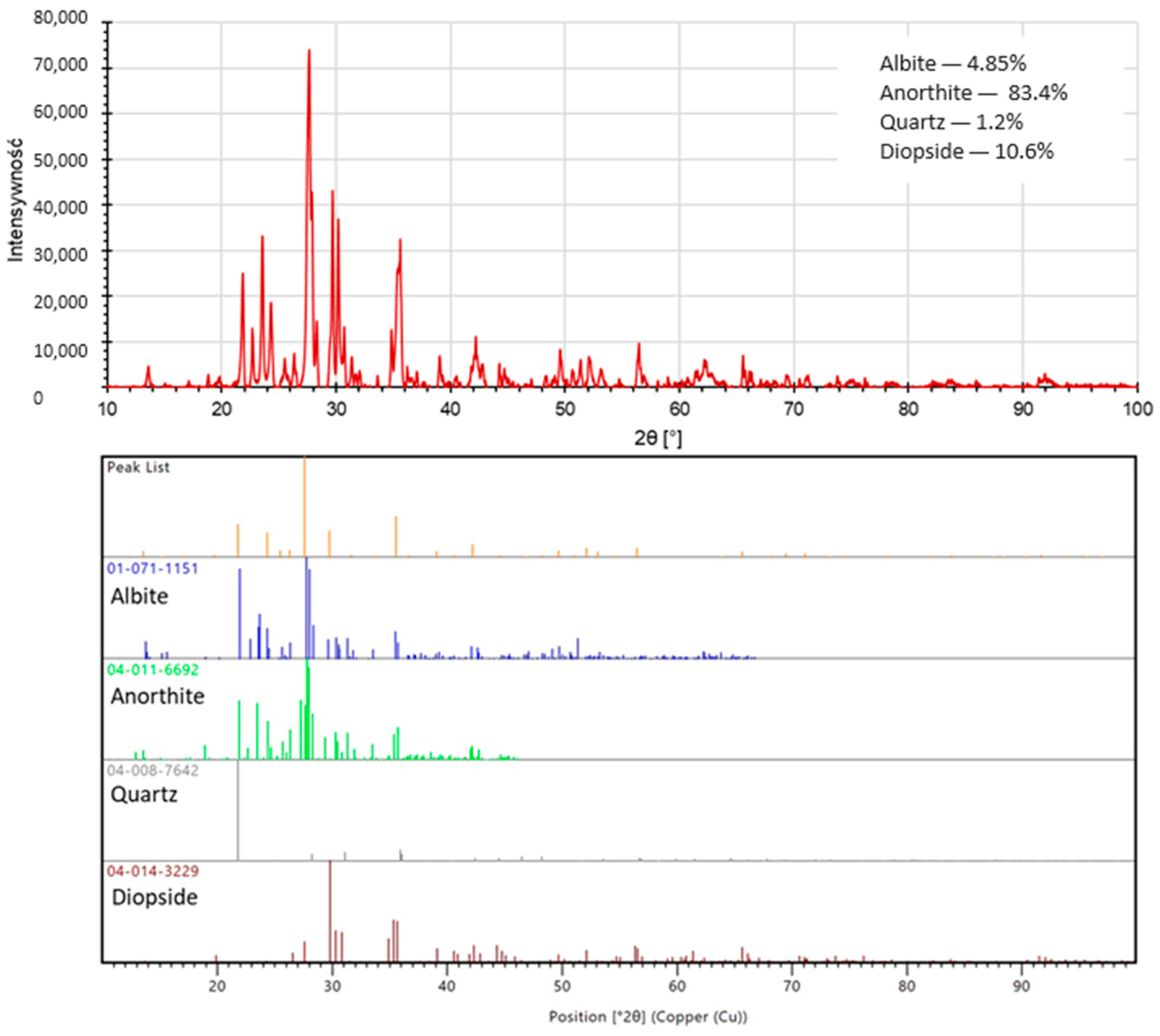
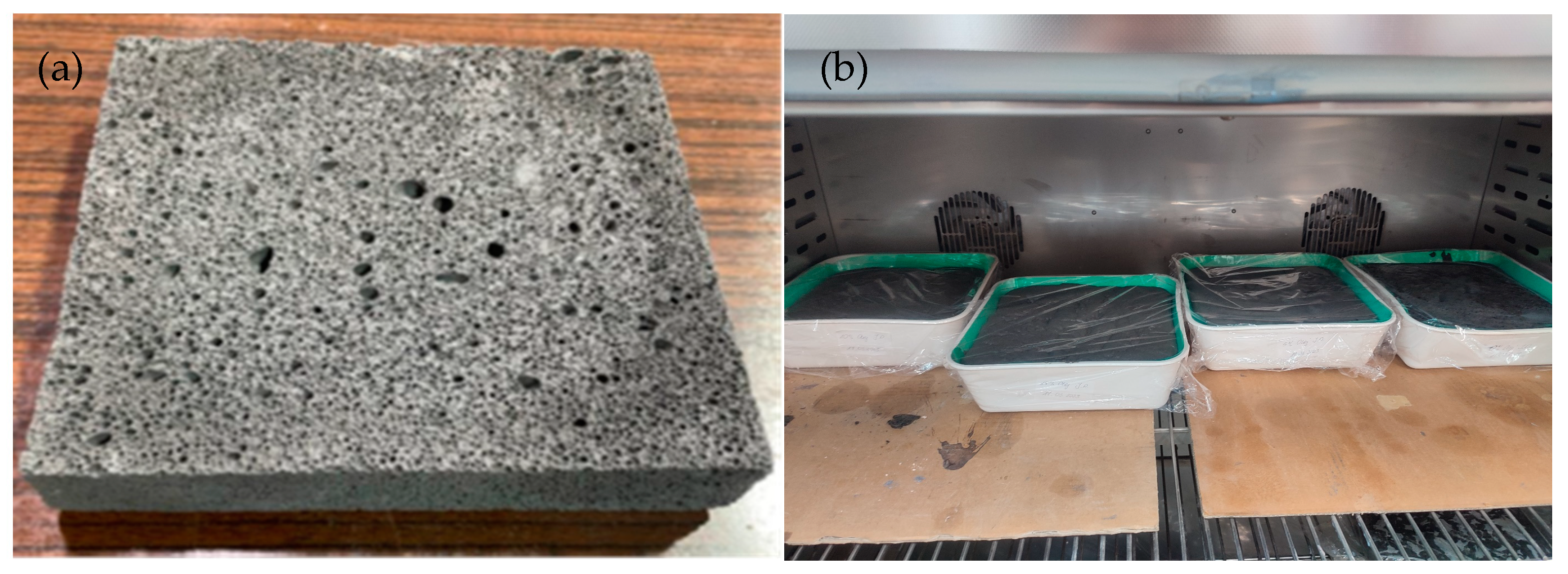
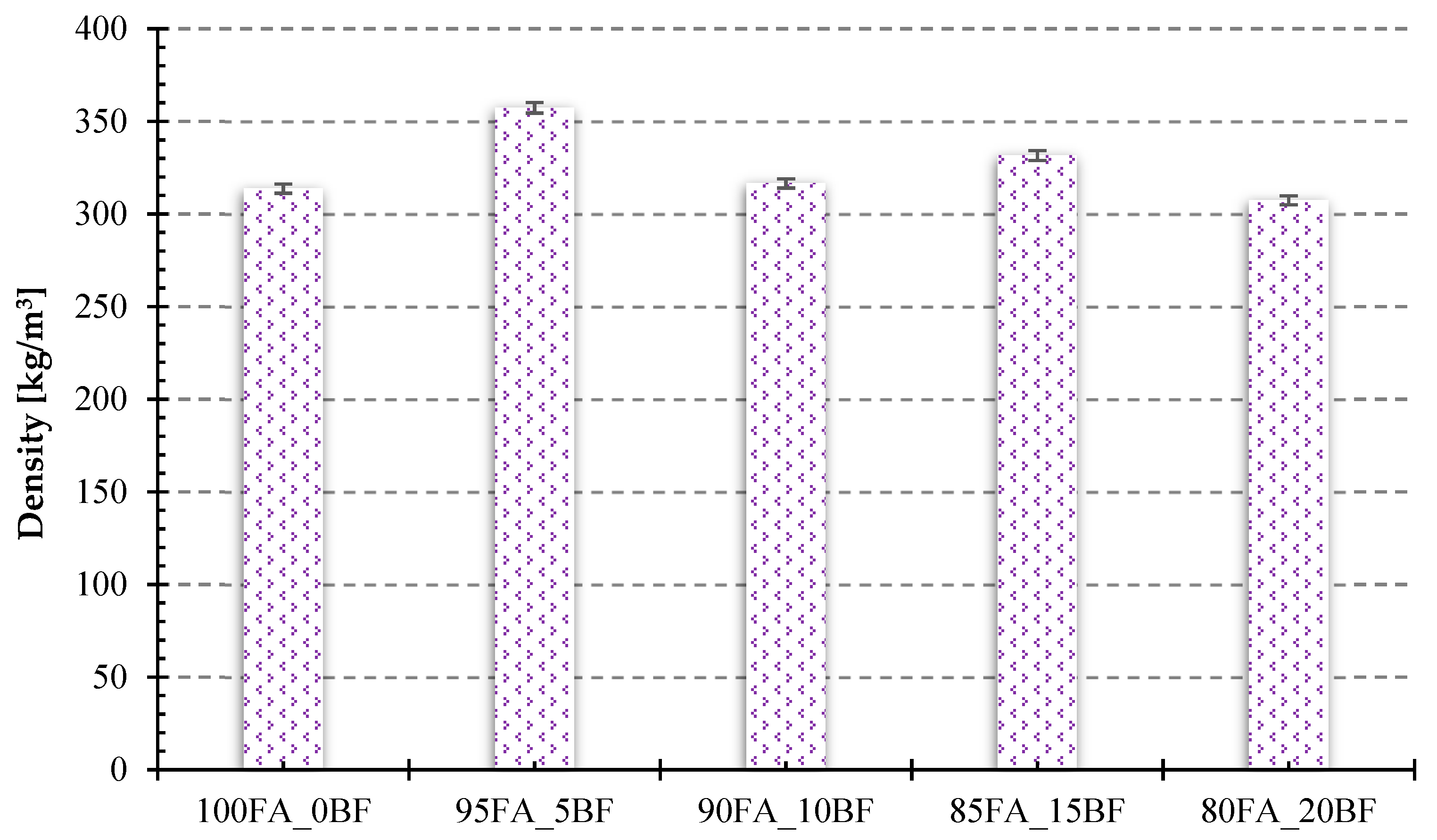
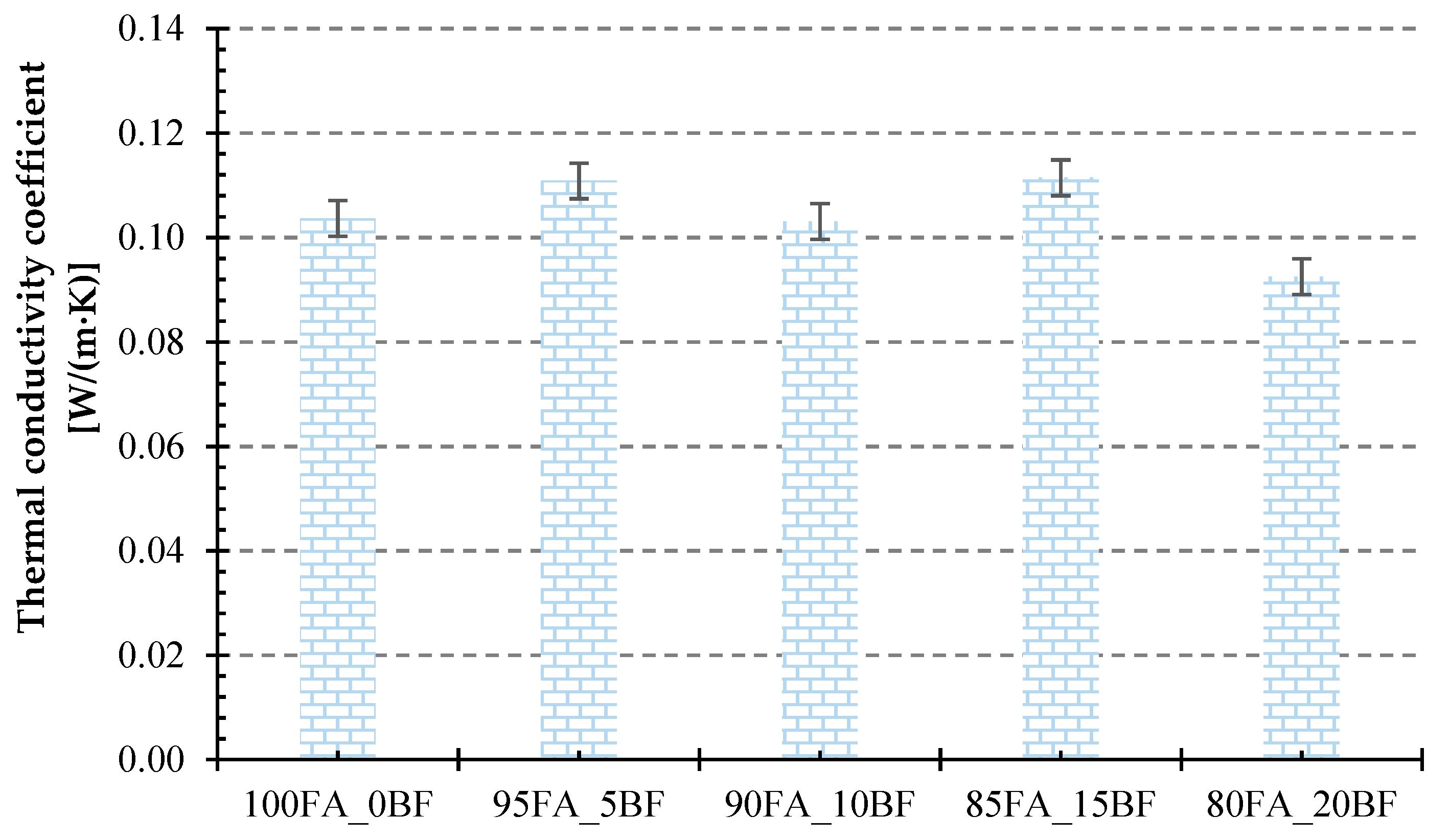


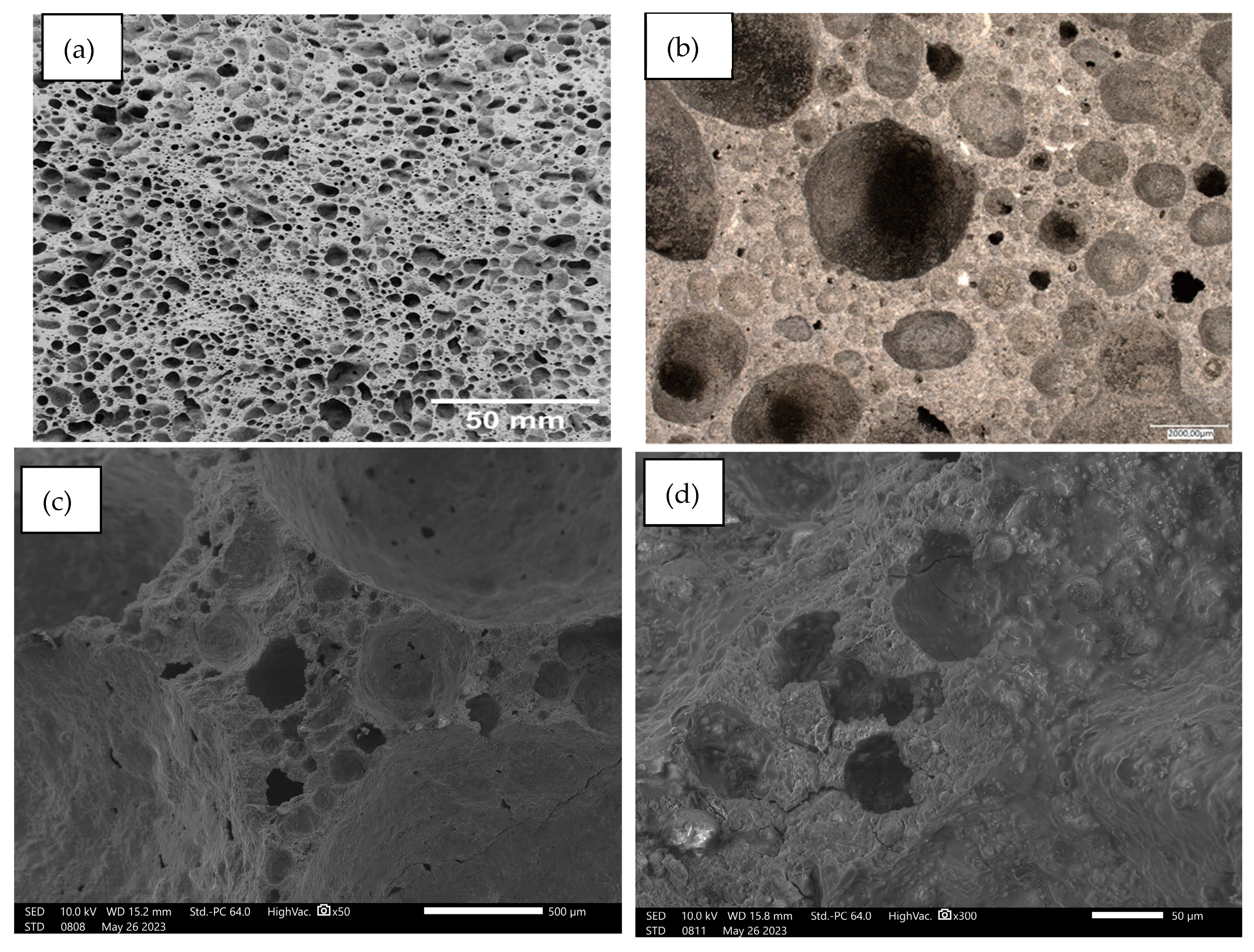
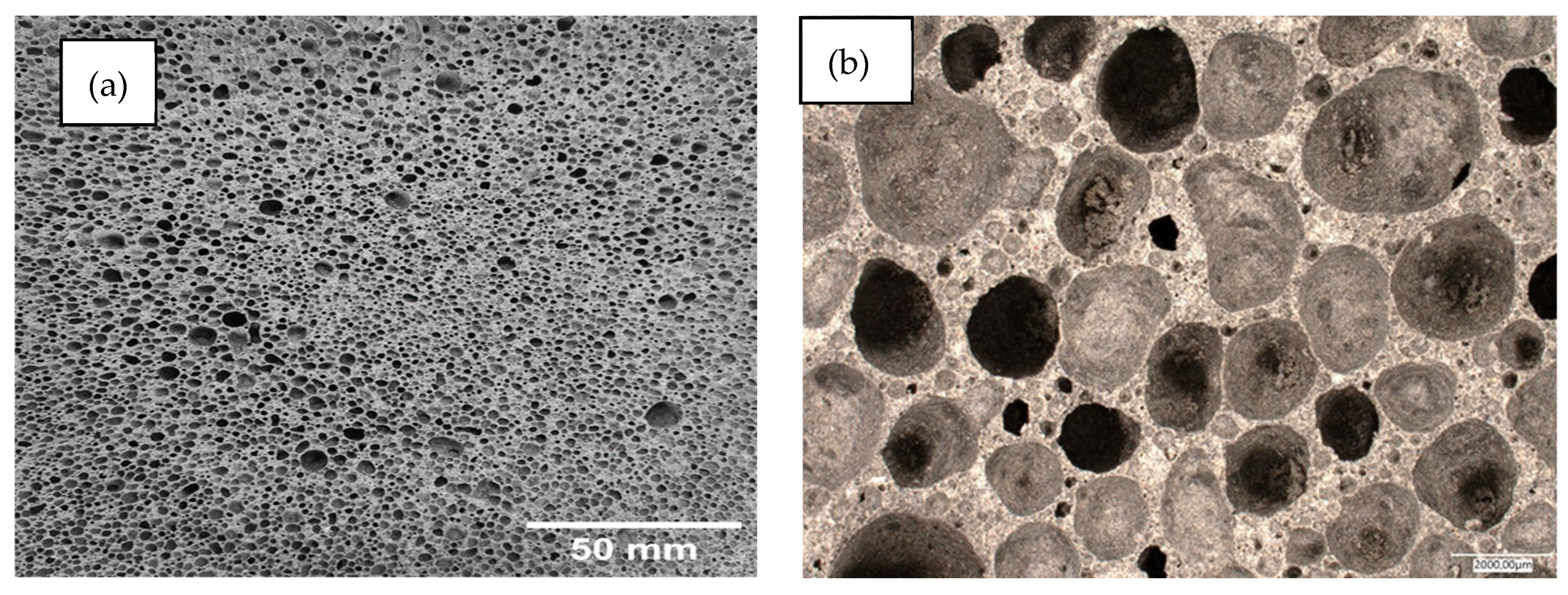

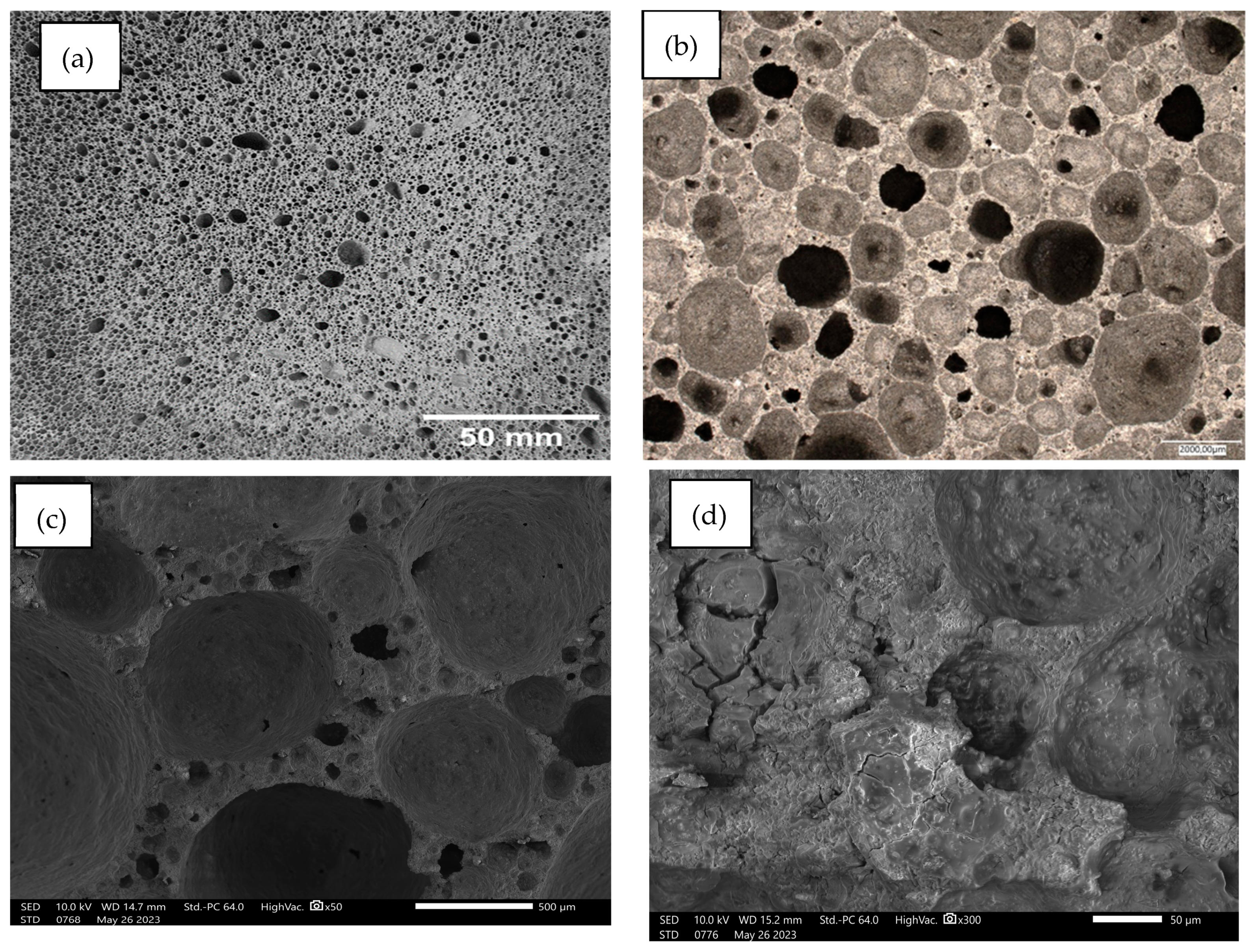

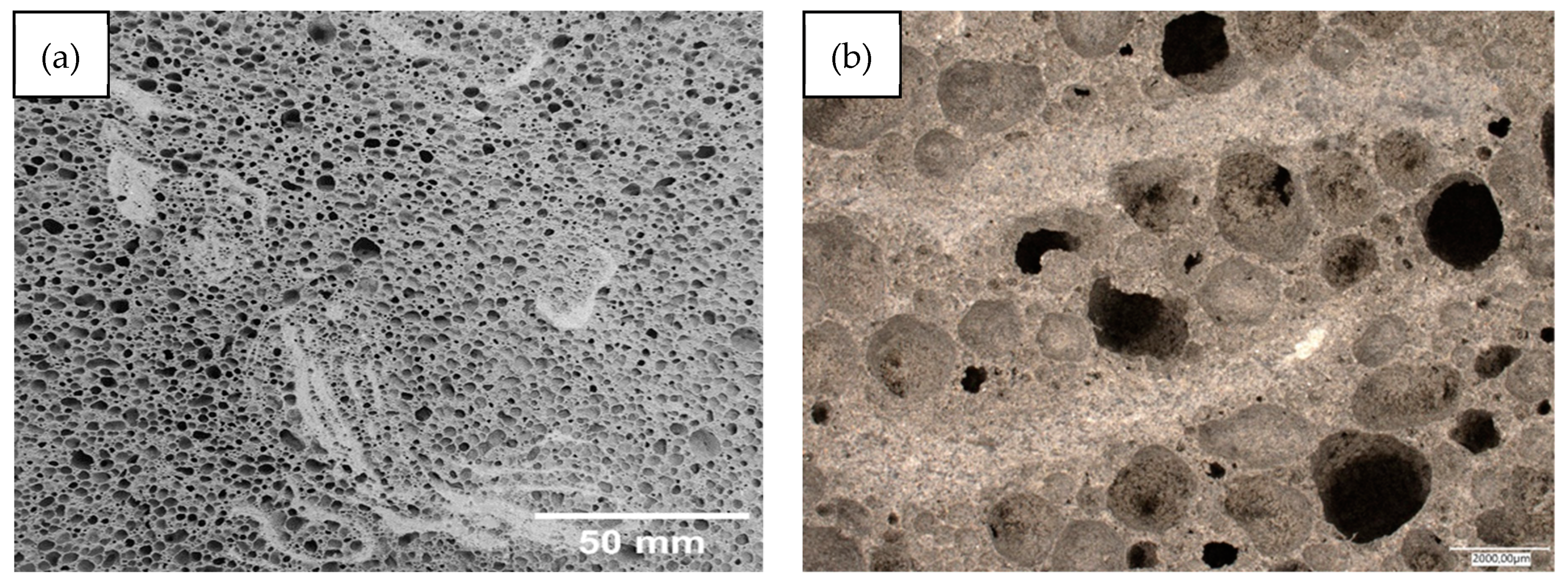
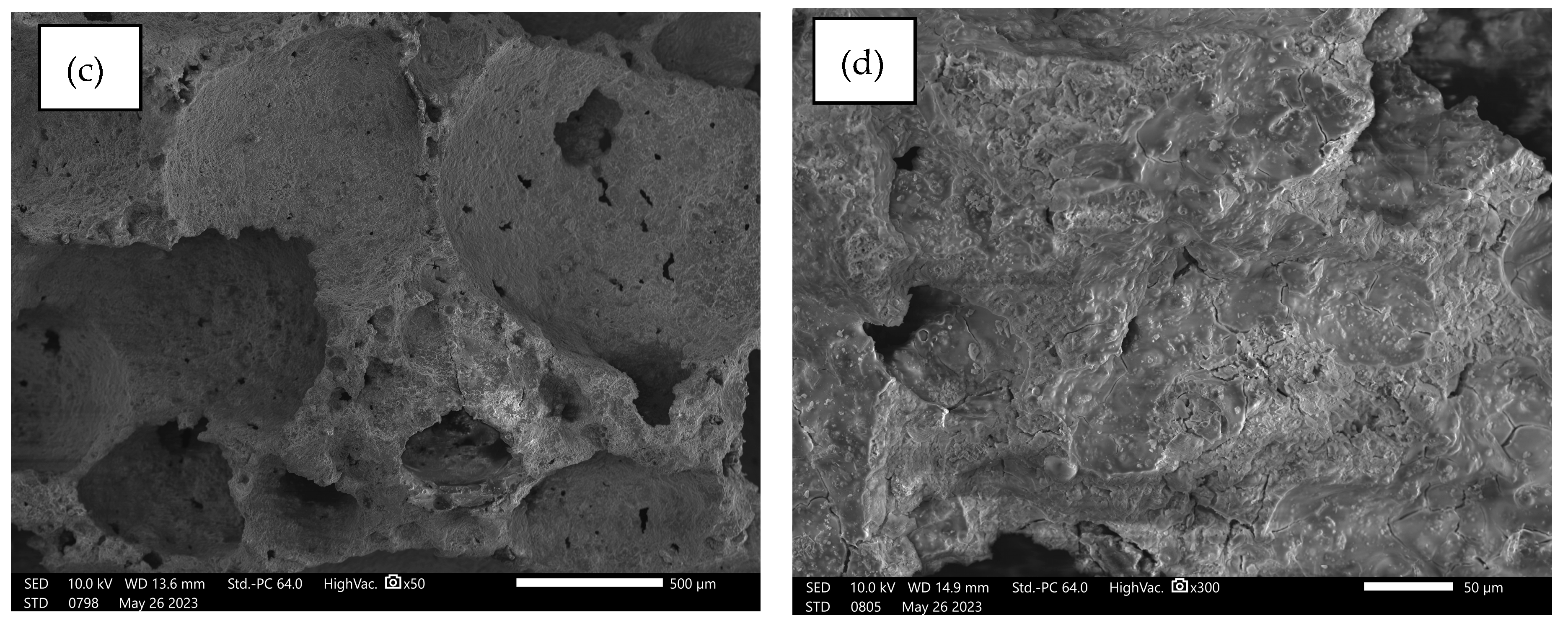
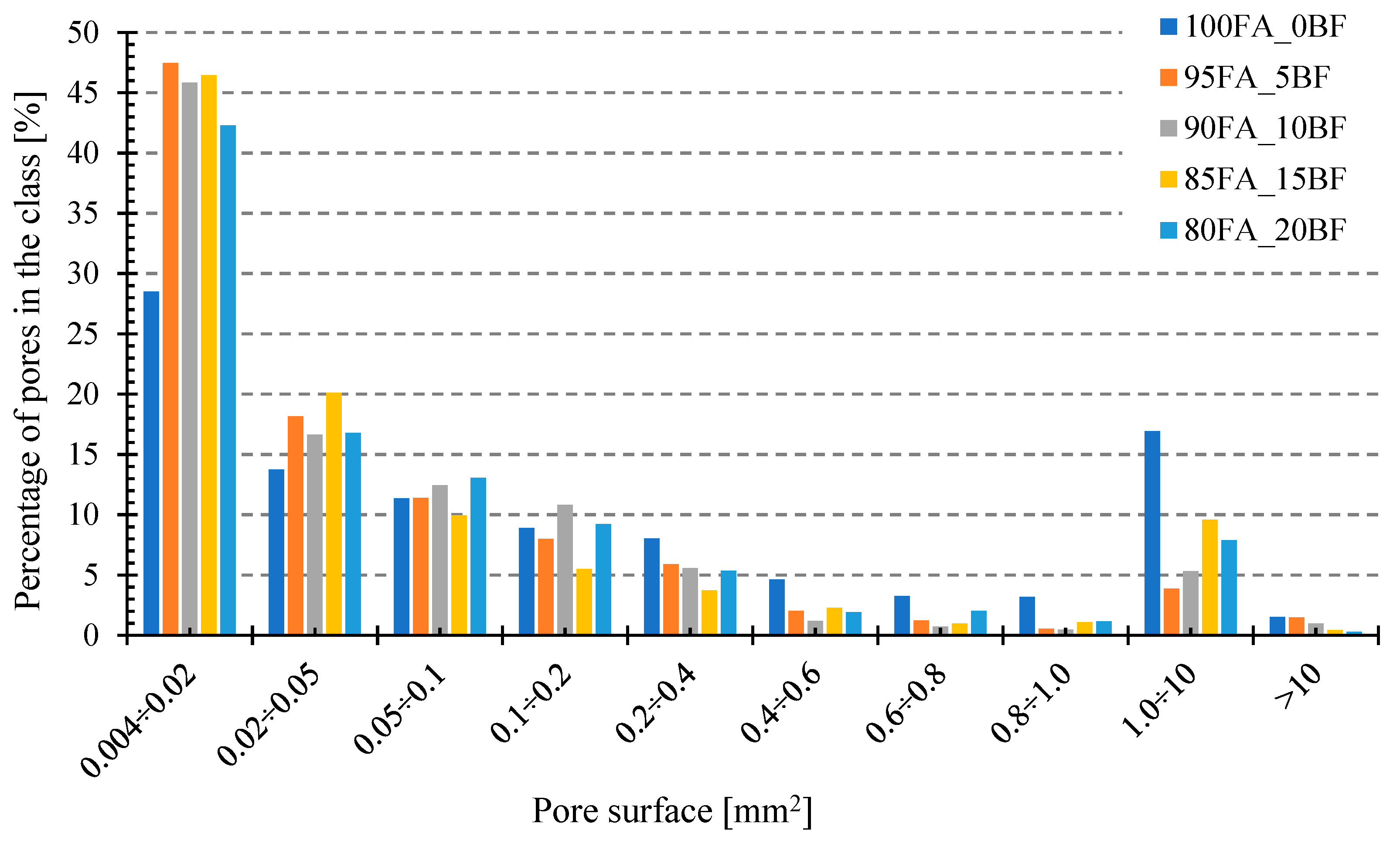

| Precursor | Oxide Composition (wt.%) | ||||||
|---|---|---|---|---|---|---|---|
| SiO2 | TiO2 | Fe2O3 | Al2O3 | CaO | MgO | K2O | |
| Fly ash | 56.64 ± 0.32 | 0.87 ± 0.01 | 4.99 ± 0.01 | 30.57 ± 0.41 | 2.79 ± 0.02 | 0.1 ± 0.01 | 2.74 ± 0.01 |
| Basalt | 46.92 ± 0.10 | 2.66 ± 0.03 | 17.48 ± 0.01 | 13.01 ± 0.08 | 10.55 ± 0.01 | 5.95 ± 0.11 | 1.20 ± 0.01 |
| D₁₀ [μm] | D₅₀ [μm] | D₉₀ [μm] | Average Value [μm] | ||
|---|---|---|---|---|---|
| Fly ash | Average value | 2.09 | 11.00 | 25.42 | 13.26 |
| Standard deviation | 0.08 | 0.21 | 0.76 | 0.30 | |
| Basalt powder | Average value | 2.62 | 20.48 | 55.71 | 26.72 |
| Standard deviation | 0.01 | 0.14 | 0.30 | 0.15 |
| Sample ID | Mass Share [%] | |
|---|---|---|
| Fly Ash | Basalt Powder | |
| 100FA_0BF | 100 | 0 |
| 95FA_5BF | 95 | 5 |
| 90FA_10BF | 90 | 10 |
| 85FA_15BF | 85 | 15 |
| 80FA_20BF | 80 | 20 |
| Components of the Geopolymer Mix | Amount per 1000 g of Fly Ash |
|---|---|
| Gypsum | 100 g |
| Cellulose | 5 g |
| Alkaline solution | 440 mL |
| Hydrogen peroxide | 30 mL |
| 100FA_0BF | 95FA_5BF | 90FA_10BF | 85FA_15BF | 80FA_20BF | |
|---|---|---|---|---|---|
| Compressive strength [MPa] | 0.89 | 1.45 | 0.91 | 0.84 | 0.71 |
| Flexural strength [MPa] | 0.56 | 0.67 | 0.45 | 0.40 | 0.34 |
Disclaimer/Publisher’s Note: The statements, opinions and data contained in all publications are solely those of the individual author(s) and contributor(s) and not of MDPI and/or the editor(s). MDPI and/or the editor(s) disclaim responsibility for any injury to people or property resulting from any ideas, methods, instructions or products referred to in the content. |
© 2024 by the authors. Licensee MDPI, Basel, Switzerland. This article is an open access article distributed under the terms and conditions of the Creative Commons Attribution (CC BY) license (https://creativecommons.org/licenses/by/4.0/).
Share and Cite
Łach, M.; Kozub, B.; Bednarz, S.; Bąk, A.; Melnychuk, M.; Masłoń, A. The Influence of the Addition of Basalt Powder on the Properties of Foamed Geopolymers. Materials 2024, 17, 2336. https://doi.org/10.3390/ma17102336
Łach M, Kozub B, Bednarz S, Bąk A, Melnychuk M, Masłoń A. The Influence of the Addition of Basalt Powder on the Properties of Foamed Geopolymers. Materials. 2024; 17(10):2336. https://doi.org/10.3390/ma17102336
Chicago/Turabian StyleŁach, Michał, Barbara Kozub, Sebastian Bednarz, Agnieszka Bąk, Mykola Melnychuk, and Adam Masłoń. 2024. "The Influence of the Addition of Basalt Powder on the Properties of Foamed Geopolymers" Materials 17, no. 10: 2336. https://doi.org/10.3390/ma17102336
APA StyleŁach, M., Kozub, B., Bednarz, S., Bąk, A., Melnychuk, M., & Masłoń, A. (2024). The Influence of the Addition of Basalt Powder on the Properties of Foamed Geopolymers. Materials, 17(10), 2336. https://doi.org/10.3390/ma17102336








